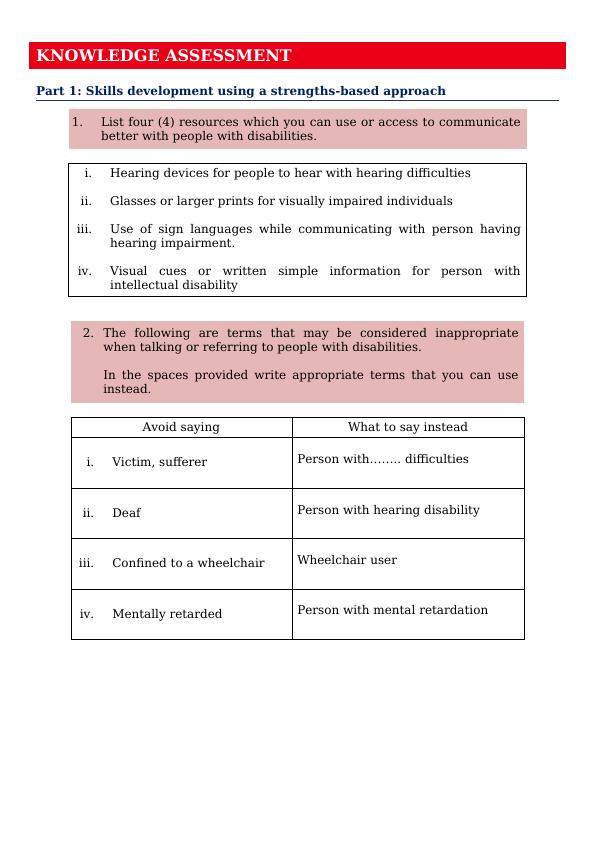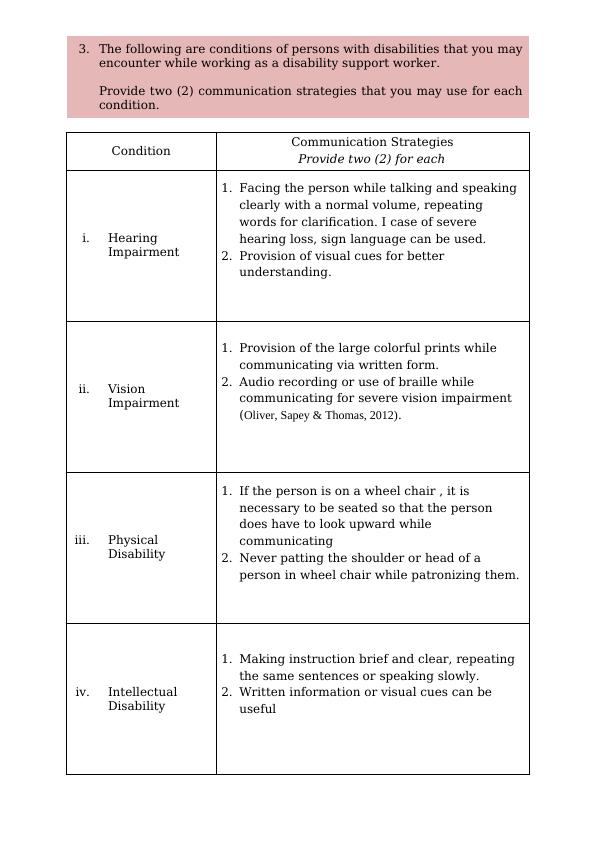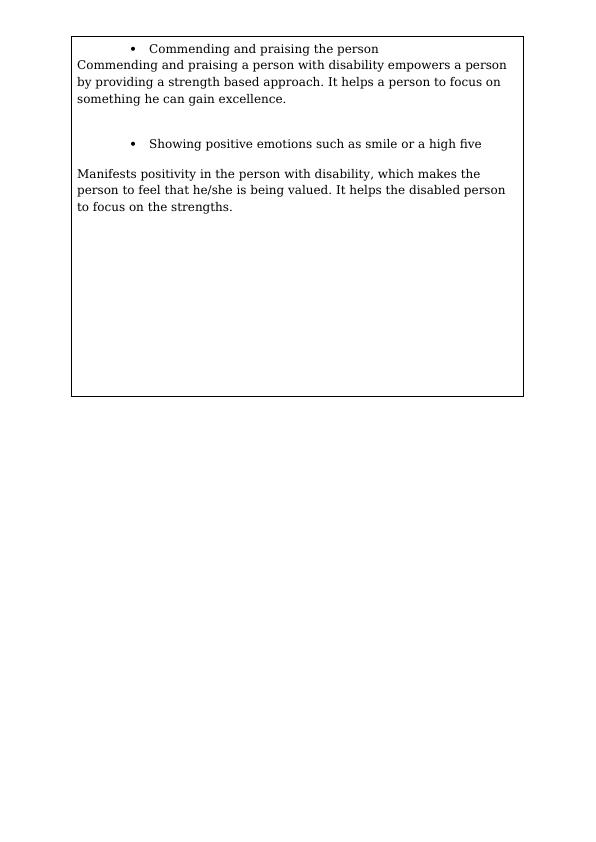KNOWLEDGE ASSESSMENT Part 1: Skills development using a
Added on 2023-04-20
21 Pages3994 Words267 Views
KNOWLEDGE ASSESSMENT
Part 1: Skills development using a strengths-based approach
1. List four (4) resources which you can use or access to communicate
better with people with disabilities.
i. Hearing devices for people to hear with hearing difficulties
ii. Glasses or larger prints for visually impaired individuals
iii. Use of sign languages while communicating with person having
hearing impairment.
iv. Visual cues or written simple information for person with
intellectual disability
2. The following are terms that may be considered inappropriate
when talking or referring to people with disabilities.
In the spaces provided write appropriate terms that you can use
instead.
Avoid saying What to say instead
i. Victim, sufferer Person with........ difficulties
ii. Deaf Person with hearing disability
iii. Confined to a wheelchair Wheelchair user
iv. Mentally retarded Person with mental retardation
Part 1: Skills development using a strengths-based approach
1. List four (4) resources which you can use or access to communicate
better with people with disabilities.
i. Hearing devices for people to hear with hearing difficulties
ii. Glasses or larger prints for visually impaired individuals
iii. Use of sign languages while communicating with person having
hearing impairment.
iv. Visual cues or written simple information for person with
intellectual disability
2. The following are terms that may be considered inappropriate
when talking or referring to people with disabilities.
In the spaces provided write appropriate terms that you can use
instead.
Avoid saying What to say instead
i. Victim, sufferer Person with........ difficulties
ii. Deaf Person with hearing disability
iii. Confined to a wheelchair Wheelchair user
iv. Mentally retarded Person with mental retardation

3. The following are conditions of persons with disabilities that you may
encounter while working as a disability support worker.
Provide two (2) communication strategies that you may use for each
condition.
Condition Communication Strategies
Provide two (2) for each
i. Hearing
Impairment
1. Facing the person while talking and speaking
clearly with a normal volume, repeating
words for clarification. I case of severe
hearing loss, sign language can be used.
2. Provision of visual cues for better
understanding.
ii. Vision
Impairment
1. Provision of the large colorful prints while
communicating via written form.
2. Audio recording or use of braille while
communicating for severe vision impairment
(Oliver, Sapey & Thomas, 2012).
iii. Physical
Disability
1. If the person is on a wheel chair , it is
necessary to be seated so that the person
does have to look upward while
communicating
2. Never patting the shoulder or head of a
person in wheel chair while patronizing them.
iv. Intellectual
Disability
1. Making instruction brief and clear, repeating
the same sentences or speaking slowly.
2. Written information or visual cues can be
useful
encounter while working as a disability support worker.
Provide two (2) communication strategies that you may use for each
condition.
Condition Communication Strategies
Provide two (2) for each
i. Hearing
Impairment
1. Facing the person while talking and speaking
clearly with a normal volume, repeating
words for clarification. I case of severe
hearing loss, sign language can be used.
2. Provision of visual cues for better
understanding.
ii. Vision
Impairment
1. Provision of the large colorful prints while
communicating via written form.
2. Audio recording or use of braille while
communicating for severe vision impairment
(Oliver, Sapey & Thomas, 2012).
iii. Physical
Disability
1. If the person is on a wheel chair , it is
necessary to be seated so that the person
does have to look upward while
communicating
2. Never patting the shoulder or head of a
person in wheel chair while patronizing them.
iv. Intellectual
Disability
1. Making instruction brief and clear, repeating
the same sentences or speaking slowly.
2. Written information or visual cues can be
useful

4. List five (5) tools or aids, equipment, and resources used in
learning processes within skills development.
i. ICT (Computer and the electrical assistive devices for teaching
the people with cognitive impairment.
ii. Computer software programs like voice recognition programs,
screen enlargement devices, automated page turners.
iii. Book holders, adapted pencil grip for helping the learners to
participate in the educational activities
iv. Use of powerpoint presentations for the visual cues.
v. Hearing aids for people to hear more clearly.
vi. Physical modifications in the classroom.
5. List three (3) services and resources made available to people
with disability for knowledge and skills development.
i. Online websites providing contacts of important services
ii. Online educational programs for knowledge and skill
development (Seewooruttun & Scior, 2014).
iii. Special classes and institutes for the disabled people
6. Briefly discuss when and how to use the following reinforcing
techniques for skills development:
Commending and praising the person
Showing positive emotions such as smile or a high five
Guidance: Your discussion must be between 20 – 150 words in
length.
learning processes within skills development.
i. ICT (Computer and the electrical assistive devices for teaching
the people with cognitive impairment.
ii. Computer software programs like voice recognition programs,
screen enlargement devices, automated page turners.
iii. Book holders, adapted pencil grip for helping the learners to
participate in the educational activities
iv. Use of powerpoint presentations for the visual cues.
v. Hearing aids for people to hear more clearly.
vi. Physical modifications in the classroom.
5. List three (3) services and resources made available to people
with disability for knowledge and skills development.
i. Online websites providing contacts of important services
ii. Online educational programs for knowledge and skill
development (Seewooruttun & Scior, 2014).
iii. Special classes and institutes for the disabled people
6. Briefly discuss when and how to use the following reinforcing
techniques for skills development:
Commending and praising the person
Showing positive emotions such as smile or a high five
Guidance: Your discussion must be between 20 – 150 words in
length.

Commending and praising the person
Commending and praising a person with disability empowers a person
by providing a strength based approach. It helps a person to focus on
something he can gain excellence.
Showing positive emotions such as smile or a high five
Manifests positivity in the person with disability, which makes the
person to feel that he/she is being valued. It helps the disabled person
to focus on the strengths.
Commending and praising a person with disability empowers a person
by providing a strength based approach. It helps a person to focus on
something he can gain excellence.
Showing positive emotions such as smile or a high five
Manifests positivity in the person with disability, which makes the
person to feel that he/she is being valued. It helps the disabled person
to focus on the strengths.

7. Consider motivators, de-motivators, barriers in learning for people
with disability.
a. List three (3) examples of motivators; and
b. List three (3) examples of de-motivators.
c. List three (3) examples of barriers
Motivators De-motivators Barriers
Praising and
encouragement
Reward
Fear of failure
Lack of empowerment
and empathy
Lack of proper
educators
Lack of effective
communication
Physical environment
Negative attitude and
stigmatization
Lack of assistive
technologies
8. Briefly discuss why it is important to recognise opportunities for
learning.
Guidance: Your discussion must be between 20 – 100 words in
length.
It is necessary to identify the opportunities in learning as it is the first
step of the entrepreneurship and it helps the people with disability to
understand the future aspects of their learning.
Opportunities in learning should be identified such proper educational
programs can be conducted on the basis of the strengths and the
weaknesses of the learners.
with disability.
a. List three (3) examples of motivators; and
b. List three (3) examples of de-motivators.
c. List three (3) examples of barriers
Motivators De-motivators Barriers
Praising and
encouragement
Reward
Fear of failure
Lack of empowerment
and empathy
Lack of proper
educators
Lack of effective
communication
Physical environment
Negative attitude and
stigmatization
Lack of assistive
technologies
8. Briefly discuss why it is important to recognise opportunities for
learning.
Guidance: Your discussion must be between 20 – 100 words in
length.
It is necessary to identify the opportunities in learning as it is the first
step of the entrepreneurship and it helps the people with disability to
understand the future aspects of their learning.
Opportunities in learning should be identified such proper educational
programs can be conducted on the basis of the strengths and the
weaknesses of the learners.

Part 2: Person-centred behavior supports
1. List three (3) practices of positive behaviour support that focuses
on the individual.
i. Communicating politely with the disabled persons to make them
feel valued. Using correct choices or words or body languages
while communicating (Beadle‐Brown, Hutchinson & Whelton, 2012).
ii. Active listening to their grievances.
iii. Providing them with assistive technologies or aids making things
easier for them (Mansell & Beadle-Brown, 2012)
2. List three (3) ways of effective communication to minimise
behaviours of concern of people with disability.
Guidance: Ensure that your responses align with the principles of
effective communication.
i. Talking slowly and the using correct simple words during
communication
ii. Using proper body gestures while communicating so they do not
feel devalued.
iii. Active listening and communicating them in an environment in
which they are comfortable with.
3. List three (3) specialist services and referral options made
available for people with disability.
i. Professional counselling support for the adults, children affected
by Acquired brain injury
ii. Sensory services including the social and rehabilitation workers
iii. Schools for special education
1. List three (3) practices of positive behaviour support that focuses
on the individual.
i. Communicating politely with the disabled persons to make them
feel valued. Using correct choices or words or body languages
while communicating (Beadle‐Brown, Hutchinson & Whelton, 2012).
ii. Active listening to their grievances.
iii. Providing them with assistive technologies or aids making things
easier for them (Mansell & Beadle-Brown, 2012)
2. List three (3) ways of effective communication to minimise
behaviours of concern of people with disability.
Guidance: Ensure that your responses align with the principles of
effective communication.
i. Talking slowly and the using correct simple words during
communication
ii. Using proper body gestures while communicating so they do not
feel devalued.
iii. Active listening and communicating them in an environment in
which they are comfortable with.
3. List three (3) specialist services and referral options made
available for people with disability.
i. Professional counselling support for the adults, children affected
by Acquired brain injury
ii. Sensory services including the social and rehabilitation workers
iii. Schools for special education

End of preview
Want to access all the pages? Upload your documents or become a member.
Related Documents
Reviewing and Monitoring Individual Service Responseslg...
|10
|1961
|72
Resume and Cover Letter Writing for Mechanical Engineerslg...
|10
|2448
|492
Skills Workbook for CHC43115 Certificate IV in Disabilitylg...
|427
|61369
|52